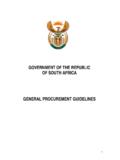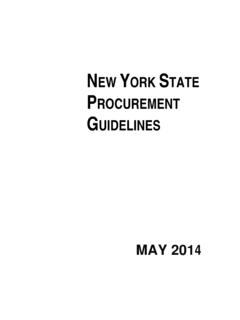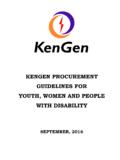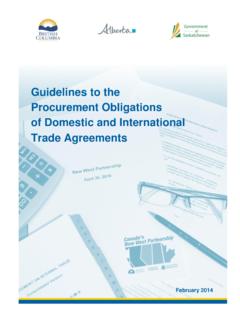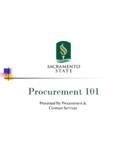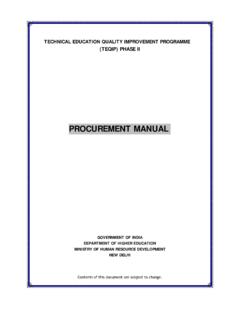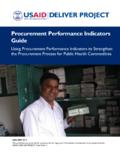Transcription of GUIDELINES On Preventing and Combating Fraud and ...
1 GUIDELINES On Preventing and Combating Fraud and corruption in Projects Financed by IBRD Loans and IDA Credits and Grants Dated October 15, 2006 Purpose and General Principles 1. These GUIDELINES are designed to prevent and combat Fraud and corruption that may occur in connection with the use of proceeds of financing from the International Bank for Reconstruction and Development (IBRD) or the International Development Association (IDA) during the preparation and/or implementation of IBRD/IDA-financed investment projects. They set out the general principles, requirements and sanctions applicable to persons and entities which receive, are responsible for the deposit or transfer of, or take or influence decisions regarding the use of, such proceeds. 2. All persons and entities referred to in paragraph 1 above must observe the highest standard of ethics.
2 Specifically, all such persons and entities must take all appropriate measures to prevent and combat Fraud and corruption , and refrain from engaging in, Fraud and corruption in connection with the use of the proceeds of IBRD or IDA financing. Legal Considerations 3. The Loan Agreement1 providing for a Loan2 governs the legal relationships between the Borrower3 and the Bank4 with respect to the particular project for which the Loan is made. The responsibility for the implementation of the project5 under the Loan Agreement, including the use of Loan proceeds, rests with the Borrower. The Bank, for 1 References in these GUIDELINES to Loan Agreement include any Guarantee Agreement providing for a guarantee by the Member Country of an IBRD Loan, Financing Agreement providing for an IDA Credit or IDA Grant, agreement providing for a project preparation advance, or Institutional Development Fund (IDF) Grant, Trust Fund Grant Agreement providing for a recipient-executed trust fund Grant in cases where these GUIDELINES are made applicable to such agreement, and the Project Agreement with a Project Implementing Entity related to an IBRD loan or IDA credit or grant.
3 2 References to Loans include IBRD loans as well as IDA credits and grants, project preparation advances, IDF grants and recipient-executed trust fund grants for projects to which these GUIDELINES are made applicable under the agreement providing for such grant, but excludes development policy lending, unless the Bank agrees with the Borrower on specified purposes for which loan proceeds may be used 3 References in these GUIDELINES to the Borrower include the recipient of a grant. In some cases, an IBRD Loan may be made to an entity other than the Member Country. In such cases, references in these GUIDELINES to Borrower include the Member Country as Guarantor of the Loan, unless the context requires otherwise. In some cases, the project, or a part of the project, is carried out by a Project Implementing Entity with which the Bank has entered into a Project Agreement.
4 In such cases, references in these GUIDELINES to the Borrower include the Project Implementing Entity, as defined in the Loan Agreement. 4 References in these GUIDELINES to the Bank include both IBRD and IDA. 5 References in these GUIDELINES to the project means the Project as defined in the Loan Agreement. its part, has a fiduciary duty under its Articles of Agreement to make arrangements to ensure that the proceeds of any loan are used only for the purposes for which the loan was granted, with due attention to considerations of economy and efficiency and without regard to political or other non-economic influences or considerations. 6 These GUIDELINES constitute an important element of those arrangements and are made applicable to the preparation and implementation of the project as provided in the Loan Agreement.
5 Scope of Application 4. The following provisions of these GUIDELINES cover Fraud and corruption that may occur in connection with the use of Loan proceeds during the preparation and implementation of a project financed, in whole or in part, by the Bank. These GUIDELINES cover Fraud and corruption in the direct diversion of Loan proceeds for ineligible expenditures, as well as Fraud and corruption engaged in for the purpose of influencing any decision as to the use of Loan proceeds. All such Fraud and corruption is deemed, for purposes of these GUIDELINES , to occur in connection with the use of Loan proceeds . 5. These GUIDELINES apply to the Borrower and other all persons or entities which either receive Loan proceeds for their own use ( , end users ), persons or entities such as fiscal agents which are responsible for the deposit or transfer of Loan proceeds (whether or not they are beneficiaries of such proceeds), and persons or entities which take or influence decisions regarding the use of Loan proceeds.
6 All such persons and entities are referred to in these GUIDELINES as recipients of Loan proceeds , whether or not they are in physical possession of such 6. The Bank s specific policy requirements on Fraud and corruption in connection with the procurement or execution of contracts for goods, works or services financed out of the proceeds of a Loan from the Bank, are covered in the GUIDELINES : Procurement under IBRD Loans and IDA Credits, May 2004, as revised October 2006 ( Procurement GUIDELINES ) and the GUIDELINES : the Selection and Employment of Consultants by World Bank Borrowers, May 2004, as revised October 2006 ( Consultant GUIDELINES ). For ease of reference, the relevant sections of the Procurement GUIDELINES and Consultant GUIDELINES are set forth in the Annex to these GUIDELINES . 6 IBRD s Articles of Agreement, Article III, Section 5(b); IDA s Articles of Agreement, Article V, Section 1(g).
7 7 Certain persons or entities may fall under more than one category identified in paragraph 5. A financial intermediary, for example, may receive payment for its services, will transfer funds to end users and will make or influence decisions regarding the use of loan proceeds. 2 Definitions of Practices Constituting Fraud and corruption 7. These GUIDELINES address the following defined practices when engaged in by recipients of Loan proceeds in connection with the use of such proceeds:8 A corrupt practice is the offering, giving, receiving or soliciting, directly or indirectly, of anything of value to influence improperly the actions of another A fraudulent practice is any act or omission, including a misrepresentation, that knowingly or recklessly10 misleads, or attempts to mislead, a party to obtain a financial or other benefit or to avoid an obligation.
8 A collusive practice is an arrangement between two or more parties designed to achieve an improper purpose, including to influence improperly the actions of another party. A coercive practice is impairing or harming, or threatening to impair or harm, directly or indirectly, any party or the property of the party to influence improperly the actions of a party. An obstructive practice is (i) deliberately destroying, falsifying, altering or concealing of evidence material to the investigation or making false statements to investigators in order to materially impede a Bank investigation into allegations of a corrupt, fraudulent, coercive or collusive practice; and/or threatening, harassing or intimidating any party to prevent it from disclosing its knowledge of matters relevant to the investigation or from pursuing the investigation, or (ii) acts intended to materially impede the exercise of the Bank s contractual rights of audit or access to 8.
9 The above practices, as so defined, are sometimes referred to collectively in these GUIDELINES as Fraud and corruption . 8 Unless otherwise specified in the Loan Agreement, whenever these terms are used in the Loan Agreement, including in the applicable General Conditions, they have the meanings set out in paragraph 7 of these GUIDELINES . 9 Typical examples of corrupt practice include bribery and kickbacks . 10 To act knowingly or recklessly , the fraudulent actor must either know that the information or impression being conveyed is false, or be recklessly indifferent as to whether it is true or false. Mere inaccuracy in such information or impression, committed through simple negligence, is not enough to constitute fraudulent practice. 11 Such rights include those provided for, inter alia, in paragraph 9(d) below.
10 3 Borrower Actions to Prevent and Combat Fraud and corruption in connection with the Use of Loan Proceeds 9. In furtherance of the above-stated purpose and general principles, the Borrower will: (a) take all appropriate measures to prevent corrupt, fraudulent, collusive, coercive and obstructive practices in connection with the use of Loan proceeds, including (but not limited to) (i) adopting appropriate fiduciary and administrative practices and institutional arrangements to ensure that the proceeds of the Loan are used only for the purposes for which the Loan was granted, and (ii) ensuring that all of its representatives12 involved with the project, and all recipients of Loan proceeds with which it enters into an agreement related to the Project, receive a copy of these GUIDELINES and are made aware of its contents.










